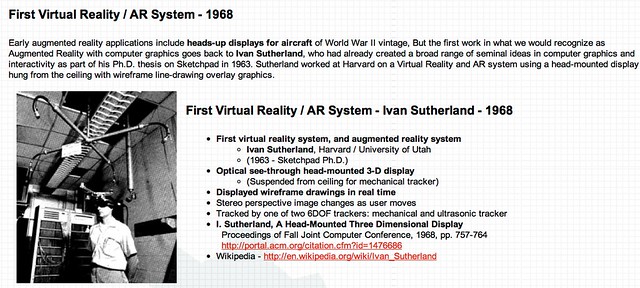Virtual Reality and augmented reality
The story begins in 1960 when Ivan Southerland created a device you mount in your head and that was capable of tracking the users viewing directions.
[Photo: AR History – First Virtual Reality / AR System – Ivan Sutherland – 1968, by Amber Case, Licence Creative Commons]
Many saw the potential of such device but also, the implication that an alternate artificial reality was already planted in the imagination of future scientists. Myron W. Kruger wrote “Artificial reality” in 1983 and many artistic works have entertain this idea.
From 1970 to 1990, there were many attempts to bring this concept to reality troughs technological innovations. Thomas Zimerman created the power glove, also known as sensing gloves capable of sensing movement. By 1981, the NASA has considered the educational potential of this device so they started flight simulator training. In 1988, Scott Fisher and Elizabeth Wenzel created a three dimensional sound system. In 1990, Tom Caudell used the word Augmented realty to referring to a virtual graphing blended into reality for electricians.
Augmented.com provides us with an info-graph on how this technology came to be.
The industry has mainly become successful in the past regarding simulator training but in the later years, we’ve seen this concept popularized mainly because of 3D-VR-360 videos and the gaming industry. Because of this, it has generated not only popularity but with it, 1.1 billion in investment.
All of these technological innovations have lead us to have all of this in our phones. if you were to search in your app store or google play store, apps and games regarding VR or Augmented reality, you would’ve never guess you are a search and a cardboard headset from an artificial world.
Virtual reality:
Virtual reality is a concept to capture the idea of experiencing a created world trough the senses. Using a cardboard headset or an Oculus Rift, one can be visually and sensory transported to another reality. VR works by adjusting an image to your eyes and giving your brain the illusion that such interactive images are real.
Another VR is also being proposed in console videogames. VR have allowed us to inmerse in fictional universes and what better to experience in the first person than horror games. Brendan Iribe and Nate Mitchell, the Co-founder of Oculus, comment on how VR will be the future of gaming.
Augmented reality:
While virtual reality creates a whole world, Augmented reality takes our world trough a camera and adds a layer of reality over the image of our camera lens. The camera has an intelligence that allows it to recognize depth, and distance along as key features that allow it to manipulate the image of said object.
Snapchat filters could be the most popularized example of Augmented reality. The Snapchat camera can identify and recognize a face along with features like eyes, nose and mouth to manipulate such image:
But it doesn’t end there, people like Edward miller are using AR for purpose of mapping via Scape:
“…we’re building a realtime, 3D map of the world that machines can understand…”
-Edward Miller
Authorities:
To keep yourself updated on the subject, one can follow to Edward Miller from Scape, Sam Watts Director of Make VR real, Palmer Luckey, founder of Modretro and co founder of Oculus along with Brendan Ribe and Nate Mitchel on Twitter.
Apps:
Probably the most popular is VRchat downloaded trough Steam. This game is created for a user to play with an avatar and interact with other users in the search of the free and vast experience of social interaction trough random avatars based on known characters from anime, videogames and pop culture in general.
http://store.steampowered.com/app/438100/VRChat/
Cardboars is another app that can explore the VR experience truogh your iphone:
https://play.google.com/store/apps/details?id=com.google.samples.apps.cardboarddemo
The biggest hit on augmented reality from your phone was the popular and world changing Pokemon GO:
https://play.google.com/store/apps/details?id=com.nianticlabs.pokemongo&hl=en
References:
Camera Augmented Reality Based Activity History Tracking. [serial online]. 20140918 2014;Available from: USPTO Patent Applications, Ipswich, MA. Accessed March 12, 2018.
Meinhold, R. P. (2013). Virtual Reality. Salem Press Encyclopedia Of Science, Retrieve from http://eds.b.ebscohost.com/eds/detail/detail?vid=2&sid=0189adaf-ab95-463b-a5c4-af9038fbf553%40pdc-v-sessmgr01&bdata=JmF1dGh0eXBlPXNzbyZjdXN0aWQ9czUzMTY1MjUmbGFuZz1lcyZzaXRlPWVkcy1saXZlJnNjb3BlPXNpdGU%3d#AN=89250621&db=ers
Leovaridis, C., & Bahn?, M. (2017). Aspects regarding virtual reality as innovation in creative industries. Revista Romana De Sociologie, 28(3/4), 157-172. Retrieved from https://go.openathens.net/redirector/sagrado.edu?url={URLencode({TargetURL})}
Mohn, E. (2015). Augmented Reality. Salem Press Encyclopedia Of Science, Retrieved from: http://eds.b.ebscohost.com/eds/detail/detail?vid=2&sid=d4fd3f5d-d721-47bb-b903-6c3c764f085b%40sessionmgr102&bdata=JmF1dGh0eXBlPXNzbyZjdXN0aWQ9czUzMTY1MjUmbGFuZz1lcyZzaXRlPWVkcy1saXZlJnNjb3BlPXNpdGU%3d#AN=87323326&db=ers
Moritz, J. (2017). Augmented humanity. Technoetic Arts: A Journal of Speculative Research, 15(3), 341-352. doi:10.1386/tear.15.3.341_1



